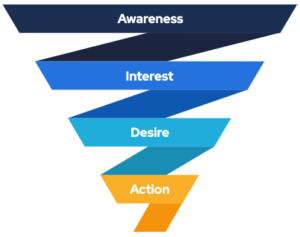The traditional marketing funnel approach, also known as the “Attention, Interest, Desire, and Action” or AIDA sales model, has been around for more than a century, having been developed by St. Elmo Lewis in 1898 to describe the personal selling experience.
But after so many years and in an era of digital marketing, is it safe to say the marketing funnel is dead, or is it still and relevant to your content marketing plan?
What is the marketing funnel?
The marketing funnel, or the AIDA model, is a logical approach to sales. AIDA stands for awareness, interest, decision, and action, and the model describes the various stages of the sales process that should ultimately lead to customer purchase.

AIDA is logically sound, especially for new products or customers new to your market or brand. It stands to reason that you must first introduce your product to your target audience and get their attention before you can go on to pique their interest by helping them understand your product and how it can benefit them.
Once your prospective customers have that level of awareness and interest, it’s then important to stimulate desire to purchase and persuade your buyers to act. Timing also comes into play here, as you want your buyer to take decisive action without delay or the opportunity to change their mind.
Although St. Elmo intended it to describe personal selling, the AIDA model has been used in marketing and advertising as a basis for designing and executing plans, and has been applied to wide-reaching campaigns including online platforms.
The three stages of the marketing funnel and what they mean
Just like a “real” funnel, the marketing funnel gets narrower the further down the funnel you go. Once you are identified as a prospective customer, you are effectively moved through a series of marketing actions, which include:
1. Awareness or lead generation
You find out about a particular brand or product through one of any number of marketing channels – at an event, on social media, through television ads or digital campaigns. If you’re being targeted correctly, the brand is hoping you’ll sign up for more information, i.e. you’ll be a lead for them.
2. Consideration or lead nurturing
Unfortunately, not everyone will have sufficient interest in your brand or product to go any further than giving you their contact details. However, those who are interested need to be nurtured. You need to grow their desire by giving them reasons to be interested. You can do this in different ways, but one of the main ways to stimulate desire in the modern era is through content marketing.
3. Customer acquisition or sales
Finally, those who have the desire to buy will actually buy – but that’s not a reason to rest on your laurels. Even with a strong desire to purchase, you still need to get customers to that point, and think about what happens after they purchase and how you can turn them into repeat customers.
Is the marketing funnel really dead?
I don’t think the marketing funnel model is totally dead quite yet – but it is evolving or gradually being replaced by modified models that are derived from the original funnel model. The traditional marketing funnel is a single path journey from wider and generic leads to narrower and fewer specific buyers. It doesn’t paint the whole complex picture of the sales and marketing process as we know it today, and that’s why it’s dying.
A marketing campaign that is designed using the AIDA model may simply create awareness for your product, and may not be highly targeted. With modern online marketing, we can be much more targeted to our ideal audience even at this stage by using specific keywords, demographic data, social media behavior models, etc.
This is particularly true if you have a very niche brand which might be focused on a few, highly specific but potentially loyal customers.
The traditional marketing model is still alive, it’s just a bit outdated and in need of modification. Instead of a funnel, we might use something along the lines of the customer journey.
What’s wrong with the traditional marketing funnel?
One of the main reasons the marketing funnel doesn’t quite fit marketing today is that as consumers, especially those buying online, rely more heavily on multiple sources of information. They’re ones that didn’t exist a century ago, and they might be out of your hands completely.
For example, about 40,000 people search for something on Google every single second. This means that keywords and content marketing matter when it comes to creating awareness – and the content you produce must be of value to your target audience. We also have access to many more reviews which help to sway our opinions, and, like it or not, we’re living in the era of the influencer. The “mouth” of the funnel now has sources of leads that are not in your control.
The internet, particularly social media, has significantly shifted the power of marketing from being dominated by large marketing and advertising agencies to being more democratized. Customers can easily share their experiences online, whether that’s to promote or criticize. They can then influence not only their family and friends, but also complete strangers.
Another problem with the traditional marketing funnel is that it doesn’t consider the fact that consumers are now more informed and powerful than ever before. In many cases, it’s a buyers’ market. Consumers also now have a much wider range of choices. Brands must spend more time and resources learning about consumer behavior, and engage with them in a more productive manner.
What’s right about the traditional marketing funnel?
In today’s highly connected and global digital age, customers or buyers can come in at any stage of the funnel and from virtually anywhere in the world. Instead of taking the linear and chronological steps of yesteryear, customers jump in at multiple points through the funnel, and they have different origins and needs. But, in general, each element of the funnel – awareness, interest, decision, action – holds true.
It’s just that the shape of the funnel itself has evolved into something better, or at least something more in tune with the modern age. It still retains some of its aspects, it’s just updated. New models are being proposed, but the classic model still works as a pretty solid template – and the new models seem to take their basis in AIDA.
If the marketing funnel is dead, what has replaced it?
The traditional marketing funnel isn’t totally dead. It has simply evolved and now serves as a template for other marketing models. In many ways, it has given birth to new marketing models. Some of the most common examples are:
- The consumer decision journey – an approach more focused on the power of informed and well-connected consumers who can influence others
- The omni-channel approach – using multiple sources of lead like mobile devices, social media, email, gaming, and print
- The marketing lifecycle model – a model that tries to describe how consumers may ultimately develop loyalty to a brand and become a brand advocate



